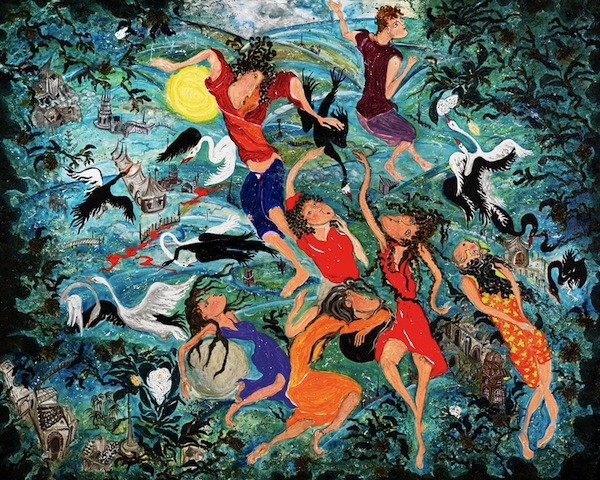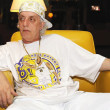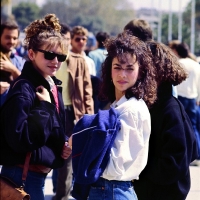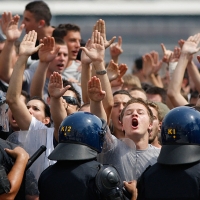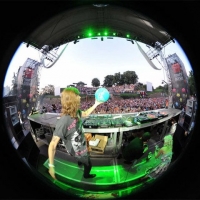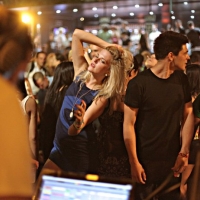The young American painter talks about his life as a second generation Ukrainian immigrant, his art career and the mystical Slavic folk tradition
The 20-year old George Pocheptsov has been in the spotlights from an early age – not because he was jumping around in The Mickey Mouse Club but because he painted phantasmagoric Slavic folklore motifs. At the age of 6, George sold a painting to Colin Powell. By the time he was 17 he had already been commissioned to create artwork for Hillary Clinton, Celine Dion and Michael Jordan. When still a teenager, he made appearances in The Oprah Winfrey Show, Good Morning America and The John Walsh Show, his artwork featured in The New York Times, People and Time magazine, fetching up to $200,000 a piece.
George creates a special kind of three-dimensional paintings by taking a regular piece of stretched canvas and putting layers of unstretched canvas over it and then sculpting different figures and painting them with multiple layers of primer, colour and modelling paste. With a flash of Chagall and young Picasso, the figures on his paintings seem stuck in a whirlpool of movement, and not unlike the Austrian secessionist Gustav Klimt, despite the bright vivid colours, the prevailing feel is that of claustrophobia and unease.
We’ve managed to catch up with George in between his exams at Harvard where he’s soon to get his academic credentials, to talk about his life as a second generation Ukrainian immigrant, his art career and the mystical Slavic folk tradition.
You started your career quite early, to say the least. You were six years old when you sold a painting to the former US Secretary of State, Colin Powell. Not really a typical childhood experience. How did it all begin?
My mother and I had been evicted from our one-bedroom apartment and sent an unforgiving shadow of poverty, grief and despair. I don’t remember the bitter night clearly, for I was an infant, but my mother’s memory and my imagination coalesce in this image of the downcast Madonna and child. With a pile of overdue bills to pay, and little understanding of the American job market, the last thing on my first-generation Ukrainian mother’s mind was her infant son’s entertainment. She would hand me an ancient pack of crayons and a few sheets of loose-leaf paper, and expect my imagination to fly. If I wanted to escape, or to express myself, it would have to be through those dreaded pieces of colored wax. And so I drew. And I flew.
Hope is a tumultuous struggle. I have survived on hope my entire life, but I felt its succor most during the bitter years after my father’s death. That final December cold snap, and the long, riotous spring that followed, gave me a reverence for the human capacity to dream, to follow the light of hope, and finally to become a beacon to others.
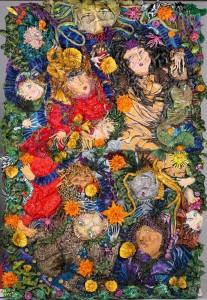 What was your childhood like? Did other children find you different or weird?
What was your childhood like? Did other children find you different or weird?
Most of my peers had no idea I was an artist. Usually a television show would do a segment on my art career at my school every year. After that, other children realized I was an artist, but not much came of the recognition besides a few jokes here and there. The biggest impact my art career had on my childhood was I never once received creative assignments or exams back from my teachers after television stations ran those segments. In other words, my teachers would keep my schoolwork as a souvenir.
You have been commissioned to create paintings for Hillary Clinton, Celine Dion and Michael Jordan, among others. How does a young artist reach such an exclusive clientele?
After starting to draw as a child, as luck would have it, in a few months time, I had amassed a substantial collection of art. My mother brought examples of my drawings and paintings to a gallery owner in Bethesda, Maryland out of simple curiosity. The owner savored the figures he saw drawn on the small pieces of paper, colored lightly with a delicate balance of crayons and markers. He said he would display it, and my work quickly found buyers. Then we ran into another problem: people wanted to meet the artist behind the canvas.
When these people did meet the artist, their jaws dropped to the floor, down where I stood at three-foot-eight. I began to be known as the ‘pint-sized Picasso’ and was summoned to television shows such as Oprah, Good Morning America, and The Today Show. Colin Powell, Hillary Clinton, Michael Jordan and Celine Dion, celebrities who I assumed lived in our television box, commissioned me to do artwork. I never relished the publicity, and no matter who commissioned a painting, I only saw my objective as filling the blank canvas in front of me.
In third grade, I established a foundation that would donate my works of art to charitable galas for auction, and to this day, I have helped raise over eight million dollars for charitable causes ranging from the Georgetown University Hospital to the establishment of a scholarship fund for my local high school. I do what I love, and I believe other people should have the opportunity to do what they love.
How would you define your ‘Slavic’ influence. What is Slavic or Eastern European in your paintings?
Three aspects of Eastern European culture influenced my artwork: Slavic folklore, the color palette (especially Ukrainian) and the Slavic Biblical icons.
Elements such as mermaids, cats, Баба Яга, Змей Горыныч and Золотая Рыбка are a few of many Eastern European folklore motifs that have adorned my artworks since a young age. In particular, in later works I began to include the motif of birds, everything from black and white swans to fiery falcons, as a tribute to the Slavic folklore motifs commonly referred to as Жар Птица and Гуси-лебеди, which can be seen in the artwork “Wings:
The Eastern European color palette in my works is clear: I love bright, bold colors, which is characteristic of the colors incorporated in Ukrainian culture. You’ll never find gore or death as a central theme in my artworks because Slavic artistic traditions largely shy away from such topics.
The Slavic Biblical icons are evidenced in my earliest works. I would incorporate biblical allusions such as St. George killing the serpent and Adam and Eve in the Garden of Eden. More recently, one of my favorite artworks, “Blessing,” created in 2009 (attached), can be interpreted as a tribute to Andrei Rublev’s “Trinity.”
Have you ever travelled to the Balkans and Eastern Europe?
Many of my private collectors are from Eastern Europe and I’ve been fortunate to have many private shows in Greece and Bulgaria. I’ve also traveled for my art exhibitions to Russia (Tretyakov Gallery) and Ukraine (Museum of Russian Art).
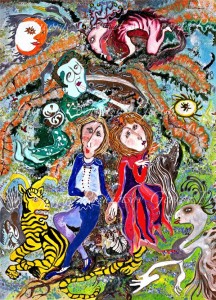 How do you see the development of painting in modern art today? In what direction you see yourself evolving in the years to come?
How do you see the development of painting in modern art today? In what direction you see yourself evolving in the years to come?
Art, particularly fine art, is gradually becoming part of the lives of regular people- not only isolated to a small group of elite collectors. The family portrait, and commissioned art, has become an accessible luxury that families have begun to treasure, passing down the generations, as an accurate portrayal of their qualities and values.
This cultural movement gives the artist an opportunity to enter a new, larger market for commissioned portraits. This is a characteristic of the 21st century, because up until this point, the art world has been dominated by a dichotomy: luxurious art for rich collectors or home decor for businesses, notably hotels.
Additionally, I don’t necessarily agree with the Wall Street Journal’s observation that portraits are becoming more abstract. That’s certainly true for select segments of the market, but in my 12 years of experience in creating commissioned artworks, I would say the more abstract interpretations lean towards the realm of business/home decor-oriented art. Commissioned artworks being accessible to the common family paves the way for a new artistic approach to portraiture- realistic portraits are transformed into impressionistic windows that characterizes who the family members are as people. Families don’t want to see their faces depicted with the hyperrealism of a photograph- that’s exactly what a high mega-pixel camera’s for. They do want to be recognizable, but with a more surrealistic portrayal of themselves and their relatives that speaks to human emotions rather than a human eye’s visual registry.
What are your main artistic influences?
My imagination and nature are my two biggest artistic influences. Most of my artworks portray the fantasies that I envision in my mind and attempt to apply to the canvas. However, a small portion of my artworks are realistic portraits done as commissions for private collections. For the private commissions, I’m influenced by the individuals who I’m painting and their lives. I find that every life on earth is colorful and breathtaking when portrayed through an artist’s brush strokes.
More info: georgepocheptsov.com


